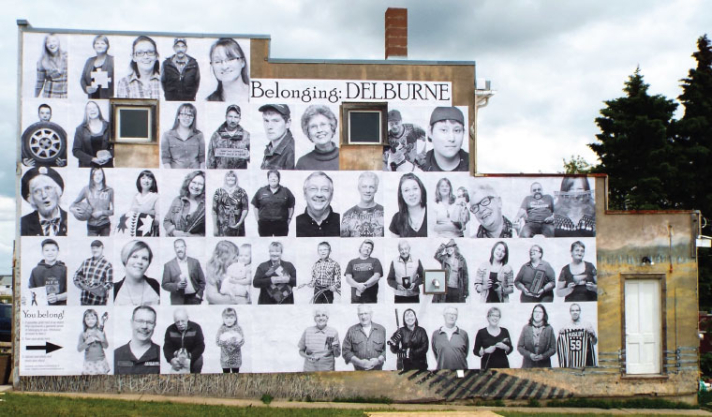We read a fascinating article that NCDD member John Backman wrote for our partners at CommunityMatters that we think you should read. John writes about an innovative civic experiment that has become an institution called the Albany Roundtable, and we hope you’ll read more about it below or find the original piece here.
 Appropriately, the idea for a bastion of civic infrastructure in Albany, New York—a luncheon series—arose from a luncheon organization.
Appropriately, the idea for a bastion of civic infrastructure in Albany, New York—a luncheon series—arose from a luncheon organization.
“I had been attending Kiwanis luncheons downtown since high school,” said Paul Bray. “At one point in 1979, I got to thinking that an open-to-all civic lunch forum might be helpful in Albany. It was my idea that it be monthly, open to the public by reservation, and have a civic or business leader speak at the luncheons.”
Thirty-five years later, the Albany Roundtable has become an institution in New York’s Capital Region. Speakers at the monthly luncheons, which typically draw 100 participants, include local leaders from healthcare, higher education, the arts, business, and other elements of the community. Just as essential, the Roundtable serves as a gathering place for civic leaders and other citizens to build their networks across sectors and industries and beyond. It helped create the basis for establishing the Albany Heritage Area which is now one of 20 state designated heritage areas. Heritage areas is a new concept of park that utilizes whole cities and/or regions as a park. Lowell, Massachusetts is the first national city as a park and there are now 49 national heritage areas including 4 in New York State that are all regions.
The Albany Roundtable’s network infrastructure barely existed when Bray first conceived the Roundtable idea. The mayor of Albany, Erastus Corning 2d, had completed 37 years in office and headed a machine with complete control over all things political. And many people believed at the time that all things were political in Albany.
“Local officials were generally deferred to on most matters,” Bray recalled. “Albany had a fair number of neighborhood associations, a historic preservation organization, numerous social service organizations, etc., etc., but they didn’t get involved in governance. There was little sense of the community at large.”
The initial meetings reflected that assessment. Speakers drew crowds largely from their own industry or venture, and attendance hovered around 35. At one point, Bray mentioned the Roundtable to Corning, a conversation that eventually led to the Roundtable’s hosting the mayor’s annual State of the City message. “Only when the mayor spoke was there a greater diversity of attendees, and attendance went up,” Bray said.
Today attendees comprise a broad cross-section of Albany, and the monthly speakers reflect that diversity. The chancellor of the State University of New York has addressed the Roundtable; so have the CEO of the largest local healthcare system, a business leader in the region’s burgeoning nanotechnology sector, directors of the best-known museums, the head of the local transit authority, and many others.
In recent years, the Roundtable has spread its activities beyond the lunch hour. Each year, it invites a visiting speaker to an evening gathering, and the roster of past speakers looks like a who’s who of livable cities. Last year’s gathering featured Jeff Speck, the author of Walkable City and an international advocate for smart growth and sustainable design; this year the speaker is Kaid Benfield, a senior leader at the National Resources Defense Council and one of the world’s “top urban thinkers” according to the city planning website Planetizen.
The Roundtable also gives out awards. The Good Patroon Award goes annually to a person or organization that makes the community a better place to live. (Bray himself won in 2004 for his work with the Roundtable.) Just last year, the organization founded the Albany Roundtable Scholarship, a $1,000 award given to a high school senior recommended by a Roundtable member.
Over the years, the Roundtable has catalyzed a number of civic projects. For example, one Roundtable attendee urged Bray to invite Fred Salvucci, the former Transportation Commissioner in Massachusetts who led the $15 billion “Big Dig” project bury a highway in downtown Boston. When he came to Albany, Salvucci met the Mayors of Albany and Schenectady, met with transportation planners about a transit connection that became the existing Bus Rapid Transit between downtown Schenectady and Albany and he saw a lot of potential for expanding Albany’s downtown and accomplishing other infrastructure projects. Salvucci organized a proposal for a diversity of projects in the Capital Region that was entitled Revest. Although many of the projects were not realized initially, it sparked the awareness the collaborative efforts are possible.
Though Bray no longer serves as Roundtable president (“It took me over 30 years to find someone who would take over”), he remains active as a board member and founder.
And he has the satisfaction of knowing that his brainchild has made a difference. “For me,” Bray noted, “the Roundtable experience has confirmed an important truth: that there is great value in community-wide opportunities for citizens to gather, break bread, and hear from the civic leaders whose decisions affect their lives.”
You can find the original version of this article at www.communitymatters.org/blog/building-civic-infrastructure-your-lunch-hour.
![]() When I told people that I was headed to LA to facilitate a conversation between evangelical pastors and scientists, most reactions fell somewhere between surprise and cynicism. “Why bother,” asked a friend, “when they’re never going to agree on anything anyway?”
When I told people that I was headed to LA to facilitate a conversation between evangelical pastors and scientists, most reactions fell somewhere between surprise and cynicism. “Why bother,” asked a friend, “when they’re never going to agree on anything anyway?”





 When the Mask Comes Off, produced by the youth media organization
When the Mask Comes Off, produced by the youth media organization